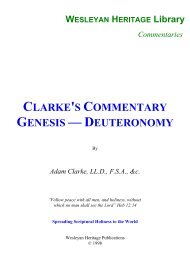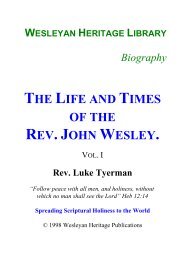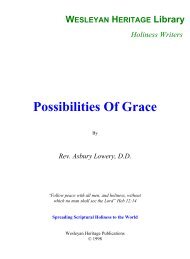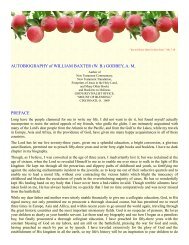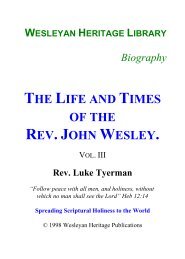2. The Meaning of Sanctification - Enter His Rest
2. The Meaning of Sanctification - Enter His Rest
2. The Meaning of Sanctification - Enter His Rest
Create successful ePaper yourself
Turn your PDF publications into a flip-book with our unique Google optimized e-Paper software.
those who already love him and evince their love by their obedience (John 14:21; 16:14).<br />
This may well be styled Paul’s second blessing.<br />
Various metaphors and phrases are employed to denote entire sanctification, as will be<br />
seen in the following texts: Eph. 4:22: “That ye put <strong>of</strong>f [aor.] the old man” [the<br />
unsanctified nature]. Here the aorist is used, because the act <strong>of</strong> putting <strong>of</strong>f is one and<br />
decisive, “referring,” says ‘Alford, “to a direct, definite, and reflexive act.” Verse 24:<br />
“And that ye put on [aor.] that new man, which after God is created [aor., was<br />
instantaneously created] in righteousness,” etc. “Beware,” says Alford, “<strong>of</strong> rendering,<br />
with Eadie and Peile, ‘that we have put <strong>of</strong>f,’ which is inconsistent with the context (vs.<br />
25), and not justified by the word ‘you’ being expressed.” This epistle is addressed to the<br />
saints and the faithful in Christ Jesus (chap. 1:1). Such undoubted Christians are exhorted<br />
by one decisive act to lay <strong>of</strong>f the old man, implying that he was not yet fully laid aside,<br />
and to put on the new man, as if Christ were not fully investing and pervading the nature.<br />
Why these aorists, if only a gradual growth out <strong>of</strong> sin into holiness is contemplated?<br />
Gal. 2:19-20: “For I through the law died [aor., quite suddenly] to the law, that I might<br />
live unto God. I have been crucified [perfect] with Christ [and stay dead till now], and it<br />
is no longer I that live, but Christ that liveth in me.’ Says Alford: “<strong>The</strong> punctuation in the<br />
English version is altogether wrong.” Here is a perfect answer, in Paul’s testimony, to the<br />
advocates <strong>of</strong> a lingering death <strong>of</strong> the old man, continuing up to the separation <strong>of</strong> soul and<br />
body. <strong>The</strong>re was a time when Paul died to sin by a crucifixion — a short and sharp kind<br />
<strong>of</strong> death — and the old man lived no more.<br />
Some people are forever on the cross, always dying but never dead, because they do not<br />
grasp the sin-slaying power.<br />
Gal. 5:24: “And they that are Christ’s crucified [aor.] the flesh, together with the passions<br />
and lusts.” From this it would appear that all believers are entirely sanctified as soon as<br />
they are regenerated. But Olshausen’s explanation is very satisfactory. “It is remarkable<br />
here that the act <strong>of</strong> crucifying is designated as past, while it is, certainly, involved in the<br />
exhortations <strong>of</strong> Paul that it is to be continued. This is explained by the fact that Paul here<br />
presents the idea <strong>of</strong> a true Christian quite objectively, and, therefore, in its completeness;<br />
as such, the believer has entirely crucified the flesh.” <strong>The</strong> only remaining question relates<br />
to the time when this completeness may be realized. Wesley says: “NOW, by faith,<br />
without doing or suffering more.” Olshausen says. “In the concrete actuality, the complete<br />
idea, and, therefore, too, the crucifying <strong>of</strong> the old man, never appear completely realized.”<br />
That is to say, the old man is completely crucified in the abstract, but in the concrete man<br />
he always lives! Common sense sides with the Englishman against the German.<br />
Gal. 4:19: “My little children, <strong>of</strong> whom I travail in birth again until Christ be formed<br />
[aor.] in you.” Here is a second spiritual birth, distinct from the first. All devout pastors<br />
find multitudes in their churches, rocking as old babes in the cradle <strong>of</strong> spiritual infancy,<br />
and they travail in birth for them, that the faint image <strong>of</strong> Christ enstamped upon them in<br />
their regeneration may be renewed and permanently deepened. Like coins on which the<br />
head <strong>of</strong> Liberty is but slightly impressed, they need to be placed beneath the die again,<br />
and receive a deep and clear impress. <strong>The</strong> aorist expresses the instantaneous reminting.<br />
Eph. 1:13: “After that you believed [aor.] ye were sealed” [aor.]. Here the believing and<br />
the sealing are acts distinct, definite, and completed.<br />
Eph. 2:5: “By grace ye have been saved” [perfect and so continue].<br />
Eph. 3:16-19: Here we have seven aorists in four verses — grant, be strengthened, dwell,<br />
or take up his abode, may be able, to comprehend, to know, and be filled. May we not<br />
infer that Paul chose this tense to convey most strongly and vividly the ability <strong>of</strong> Christ to<br />
do a great work in a short time, to save believers fully, and to endow them with the




